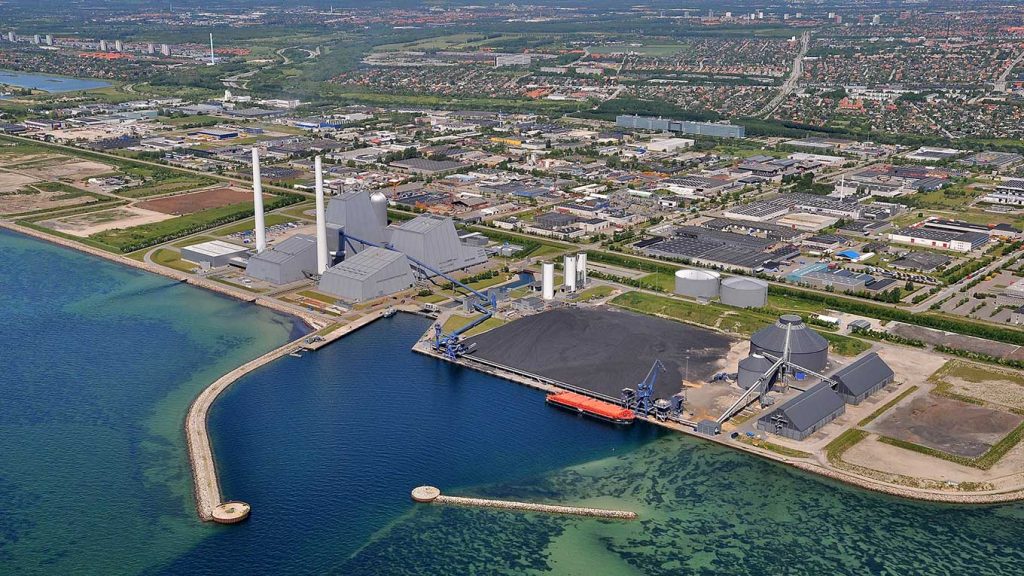
Feasibility study underway for capturing CO2 at Denmark CHP plants
June 6, 2019
By Ramboll
 Aerial photo of the Avedøre 1 CHP plant. Photo supplied.
Aerial photo of the Avedøre 1 CHP plant. Photo supplied. A new research project carried out by Ramboll, GEUS, DTU and SINTEF studies the feasibility of using CO2 capture at Danish biomass-fired combined heat and power plants.
In Denmark, 30 per cent of all energy consumed comes from renewable sources, and the country intends to increase this percentage to 50 per cent by 2030 with the long-term goal of becoming a low-emission country, independent of fossil fuels by 2050. Denmark is far ahead in the process of changing its heat and power production from coal-fired combined heat and power plants (CHP) to renewable energy such as wind, solar and geothermal, supplemented with CO2 neutral bioenergy (biomass, biofuel and biogas).
With 70 per cent of the renewable energy consumption in Denmark being bioenergy-based, this offers the opportunity to change the bioenergy from being CO2 neutral to being CO2 negative by implementing carbon capture and storage.
So far technology used for carbon capture and storage has been way too expensive, and previous attempts at implementing the technology at CHP plants have been abandoned.
Now, a techno-economic study of the feasibility of a future integrated CO2 neutral energy system, where the subsurface is utilised for thermal energy supply and storage, as well as temporary CO2 storage is being performed as part of a research project carried out by Ramboll, GEUS, DTU and SINTEF. The study is supported by the Danish energy technology development and demonstration research programme EUDP.
“The study looks very promising so far, and the technology used seems to be technically feasible for major CHP plants based on biomass, and with heat recovery for district heating, the economic feasibility has improved dramatically”, says Ramboll engineer Thomas Paarup Pedersen, who is part of the core research team.
The study analyses a generic bio-plant retrofitted with a CO2 capture. The generic bio-plant is benchmarked against a reference power plant, the biomass-fired Avedøre 1 CHP plant, located in the outskirts of Copenhagen. The plant has a capacity of 640 MWth, with net electric power output of 219 MWel and district heating production of 352 MWth at full-load conditions. The plant operates with 100 per cent wood pellets. The Avedøre plant is considered representative of a state-of-the-art power plant that has been converted from operating with coal to biomass.
In the modelling work, the bio-plant is retrofitted with so-called Monoethanolamine (MEA) capture technology, a well-known carbon capture technique of CO2 absorption by using amines. In the process, steam from the CHP production is used to regenerate the amine used to capture CO2. When leaving the capture plant, the CO2 is compressed to 110 bar, transported by pipeline 3 km towards northeast, and injected into a storage reservoir in 1300 metres depth. 30 years injection of 1 million tonnes/year of CO2 is feasible from one injection well. The transport and injection case is based on capture from Nordjyllandsværket CHP plant after possible conversion to biomass-firing.
The research results so far show that it is possible to recover a considerable amount of heat from the CO2 capture process to the DH system for use in the district heating system, significantly improving the thermal efficiency of the bio-plant and consequently reducing the cost of CO2 capture by roughly 30%, or from €77 to €52 per tonne of CO2 captured.
The final results of the research project will be presented at the TCCS-10 conference in Trondheim in Norway on 17-19 June 2019.
Print this page